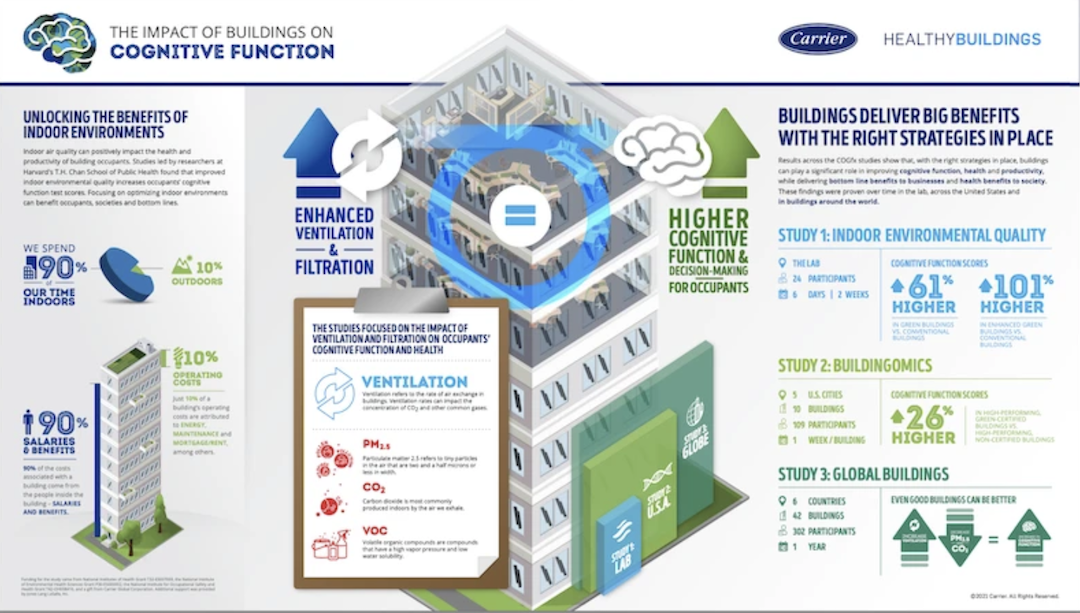Enhanced ventilation and filtration can improve the cognitive function and health of a building’s occupants, and should be the preeminent strategy for healthy buildings.
That’s the conclusion of COGfx Study 3: Global Buildings, new research by the Harvard T.H. Chan School of Global Health, which has been investigating the relationship between indoor air quality and cognitive performance since 2014. The latest study is the first to take a global approach, encompassing 302 office workers in 42 buildings across 30 cities and six countries—China, India, Mexico, Thailand, the United Kingdom, and the U.S.
This study builds upon and corroborates two previous research projects that the T.H. Chan School had conducted over the past several years. The first tested 24 lab workers for six days over two weeks and found 61% higher cognitive scores among those in green vs. conventional buildings, and 100% higher scores in enhanced green buildings. The second tested 109 participants in 10 buildings and five U.S. cities over a week’s time, and recorded 26% higher cognitive scores among those people in green-certified buildings vs. high-performance but non-certified buildings.
The latest, more expansive, study tracked occupant performance over 12 months. The study concluded that occupants’ cognitive function improves by increasing a building’s ventilation (i.e., the rate of air exchange) in ways that reduce its interior inhalable particulates (PM2.5 specifically) and carbon dioxide (CO2)
The third study, whose findings were released last week, used real-time environmental sensors (including wearable monitors) and a customized Harvard Healthy Buildings mobile app to collect data and administer momentary assessments of cognitive function, health, and occupant satisfaction.
IAQ IS NOW CRITICAL TO INTERIOR DESIGN
Even small effects of cognitive function and health can translate into substantive short- and long-term benefits, the study reports. “When you consider that 90% of the costs in a building are associated with the people inside, including salaries and benefits, the ability to improve cognitive performance and reduce infectious disease transmission, sick building symptoms, and missed workdays through improved air quality is powerful.”
As more people return to their workplaces and schools after prolonged pandemic quarantines, “the health, safety, and intelligence of indoor environments have come into greater focus,” says Dave Gitlin, Chairman and CEO of Carrier, the HVAC supplier which provided a gift to help fund this research. “The COGfx Study continues to demonstrate that proper ventilation and filtration of indoor environments play important roles across the globe in fostering a proactive health strategy.”
Carrier’s Healthy Buildings Program, which serves several typologies, offers innovations that include a digital, cloud-native platform for aggregating data from different systems and sensors; OptiClean, a portable negative air machine; and Indoor Air Quality assessments for devising health building strategies.
Funding for the Harvard study also came from the National Institutes of Health, the National Institute of Environmental Health Sciences, and the National Institute for Occupational Safety and Health. JLL provided additional support.
Related Stories
| Aug 11, 2010
Gold Award: Eisenhower Theater, Washington, D.C.
The Eisenhower Theater in the John F. Kennedy Center for the Performing Arts in Washington, D.C., opened in 1971. By the turn of the century, after three-plus decades of heavy use, the 1,142-seat box-within-a-box playhouse on the Potomac was starting to show its age. Poor lighting and tired, worn finishes created a gloomy atmosphere.
| Aug 11, 2010
AIA course: MEP Technologies For Eco-Effective Buildings
Sustainable building trends are gaining steam, even in the current economic downturn. More than five billion square feet of commercial space has either been certified by the U.S. Green Building Council under its Leadership in Energy and Environmental Design program or is registered with LEED. It is projected that the green building market's dollar value could more than double by 2013, to as muc...
| Aug 11, 2010
Great Solutions: Technology
19. Hybrid Geothermal Technology The team at Stantec saved $800,000 in construction costs by embedding geothermal piping into the structural piles at the WestJet office complex in Calgary, Alb., rather than drilling boreholes adjacent to the building site, which is the standard approach. Regular geothermal installation would have required about 200 boreholes, each about four-inches in diameter ...







